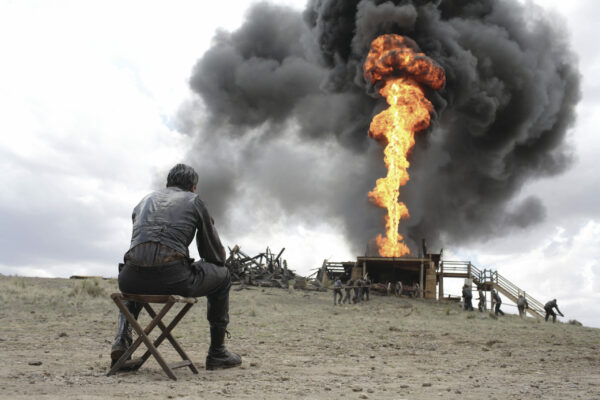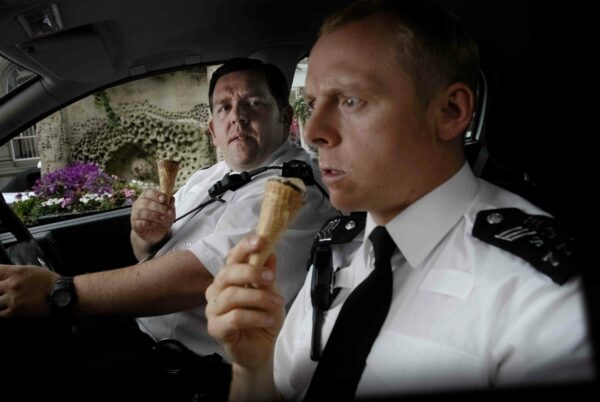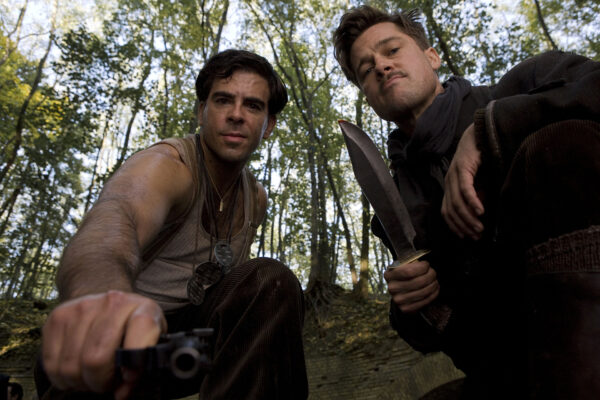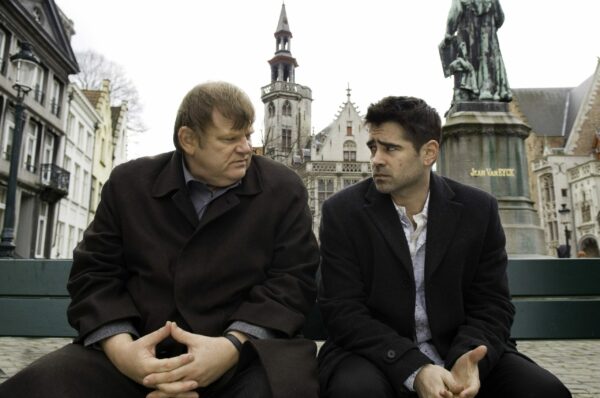
Saving Private Ryan made an impact on its release in 1998 like few war movies before or since. We have the behind the scenes story with 20 fascinating facts.
Having won great critical acclaim for Schindler’s list in 1993, Steven Spielberg returned to World War II five years later when he directed Saving Private Ryan. Again a critical smash, the film has gone down to be regarded as among Spielberg’s best and most powerful movies. We’re telling the story behind Spielberg’s classic with some huge and fascinating facts about Saving Private Ryan.
1. The film won Spielberg his second Oscar
Having started his filmmaking career in 1974 (The Sugarland Express) and suffered numerous Oscar losses as a nominee, Spielberg finally won a Best Director Academy Award in 1994 when he was honoured for Schindler’s List. Having waited two decades for his first, it was only a few short years until his second. Spielberg won his second Best Director Oscar for Saving Private Ryan.
Spielberg accepts his Best Director statue for Saving Private Ryan
2. Spielberg saw the film as an ode to his father
Spielberg’s father, Arnold Spielberg, fought in the Second World War. And it was that tie which made Steven interested in the Saving Private Ryan script. Spielberg never thought the film would be a hit though, and his first idea was about making the film as a Boy’s Own Magazine type adventure. When he started interviewing veterans, however, Spielberg favoured presenting the realism of warfare on the big screen.
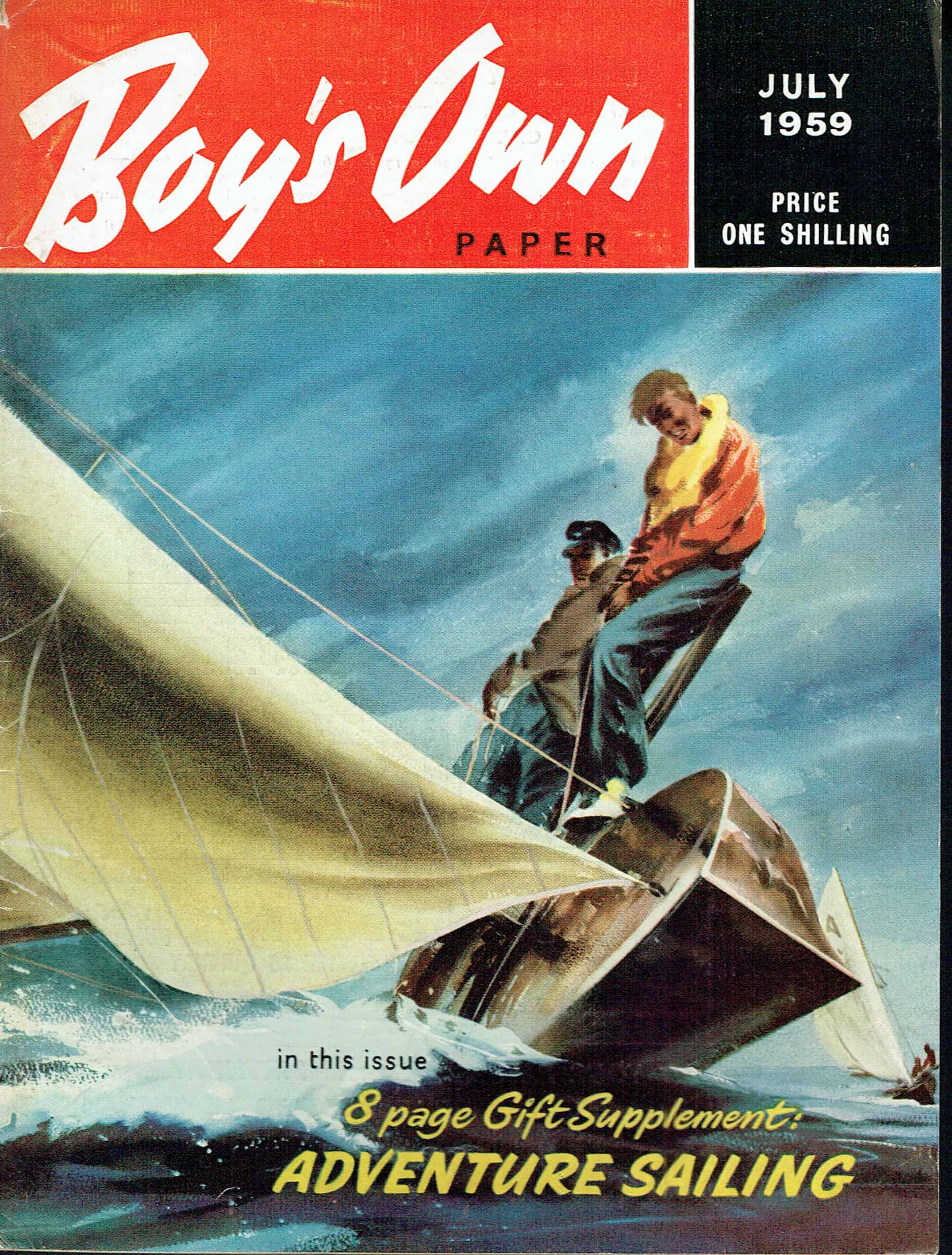
Boy’s Own Magazine, which initially inspired Spielberg
3. The film created some visual innovations
One of Steven Spielberg’s longest collaborations is with cinematographer Janusz Kaminski, who was Director of Photography on Saving Private Ryan.
Typically a camera’s shutter is set to a 180 degree angle. On Saving Private Ryan, Kaminski set the cameras to a 90 and 45 degree shutter instead, which shortens the amount of time the film is exposed to light. This, in turn, makes the image sharper. And when the film was processed, Kaminski had it run through the developer more times than usual to achieve a more washed out look. Essentially, they saturated the colour by about 50-60%. Spielberg later said, “[Kaminski’s] idea delivered a fantastic visual, and the film looks freakin’ great for it.”
Our compilation of the incredible visuals in Saving Private Ryan. Subscribe to our channel for more
4. The film won and lost at the Oscars
Having won for Schindler’s List 5 year earlier, Steven Spielberg won his second Best Director Oscar for Saving Private Ryan. The film missed out, however, on Best Picture. The winner that year was Shakespeare in Love, a period romantic comedy directed by John Madden. Shakespeare in Love pretty much dominated that year, taking home 7 statues!
Shakespeare in Love wins Best Picture
5. Studio interference improved the script
Saving Private Ryan was written by Robert Rodat. He was Oscar-nominated for the film and when you look at his other bodies of work over the years, Saving Private Ryan does stand out as the jewel in his screenwriting crown.
Rodat’s screenplay went through 11 drafts of revisions requested by the studio, and it was the studio that came up with a lot of that human drama that sites at the core of Saving Private Ryan. This includes Miller’s backstory of being a school teacher who wanted to get home to his wife. Also, “Steamboat Willie” – the German character who betrays the group – didn’t exist at first. The characters of Mellish and Caparzo came later on too. So studio revisions, not always a bad thing, necessarily.
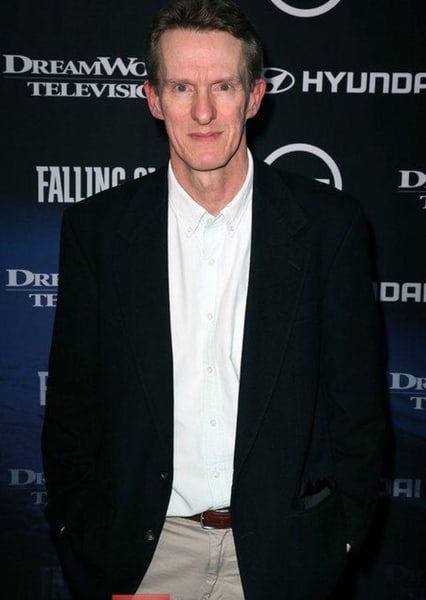
Robert Rodat, Saving Private Ryan screenwriter
6. The film is based on real events
The narrative in Saving Private Ryan is a fairly straightforward one. A group of battle-ready U.S. soldiers are sent behind enemy lines to find and retrieve the last surviving man of a family of four brothers – James Francis Ryan. As extraordinary as the story of Saving Private Ryan is, it is based on real events. Albeit rather loosely.
Robert Rodat first came up with the plot in 1994 when he saw a monument in a cemetery in Tonawanda, New York. The monument was to the Niland Brothers – 4 young American men who fought in the Second World War. When three of the Nilands were reported killed, the surviving brother – Fritz – was sent home. This inspired Rodat to write his movie.
In real life with the Nilands, it actually turned out later that another of the brothers was alive – he’d been held captive in a Burmese POW camp.
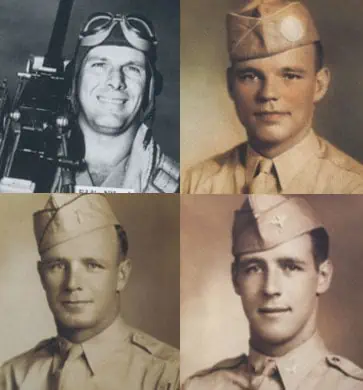
The Niland brothers – the inspiration for Saving Private Ryan
7. The letter we hear is real, too
One of the most memorable scenes in the film comes in the first act, where General Marshall reads out a letter penned by Abraham Lincoln. The letter was sent to a woman called Lydia Bixby in 1864 at the height of the American Civil War, after she lost 5 sons in battle.
Some doubt has been cast on the letter now though apparently, as historians now say that evidence suggests that only 2 of Lydia Bixby’s sons died. At least 2 of the others deserted.
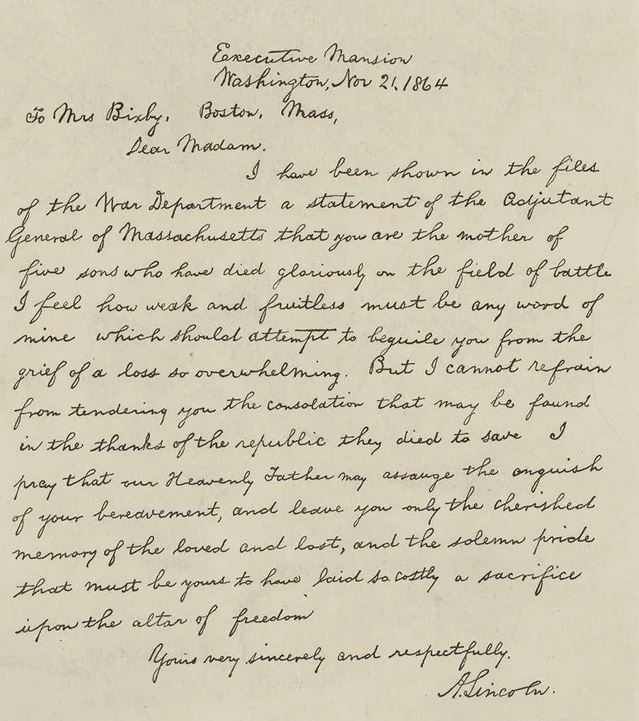
The letter from Abraham Lincoln to Lydia Bixby
8. Tom Hanks wasn’t the first person up for the lead
The character in the film we spend most time with is Captain John Miller, the head of the band of brothers sent to find Ryan and played by Tom Hanks. Hanks was one of the biggest movie stars in the world at the time but there were two other big names considered for the part before him.
Mel Gibson was a possibility. And he did go on to appear in a war movie shortly afterwards – We Were Soldiers (2002) – as well as direct World War II movie Hacksaw Ridge (2016).
Also, Spielberg considered Harrison Ford. Spielberg knew Ford very well from the Indiana Jones trilogy but decided to approach Hanks instead.
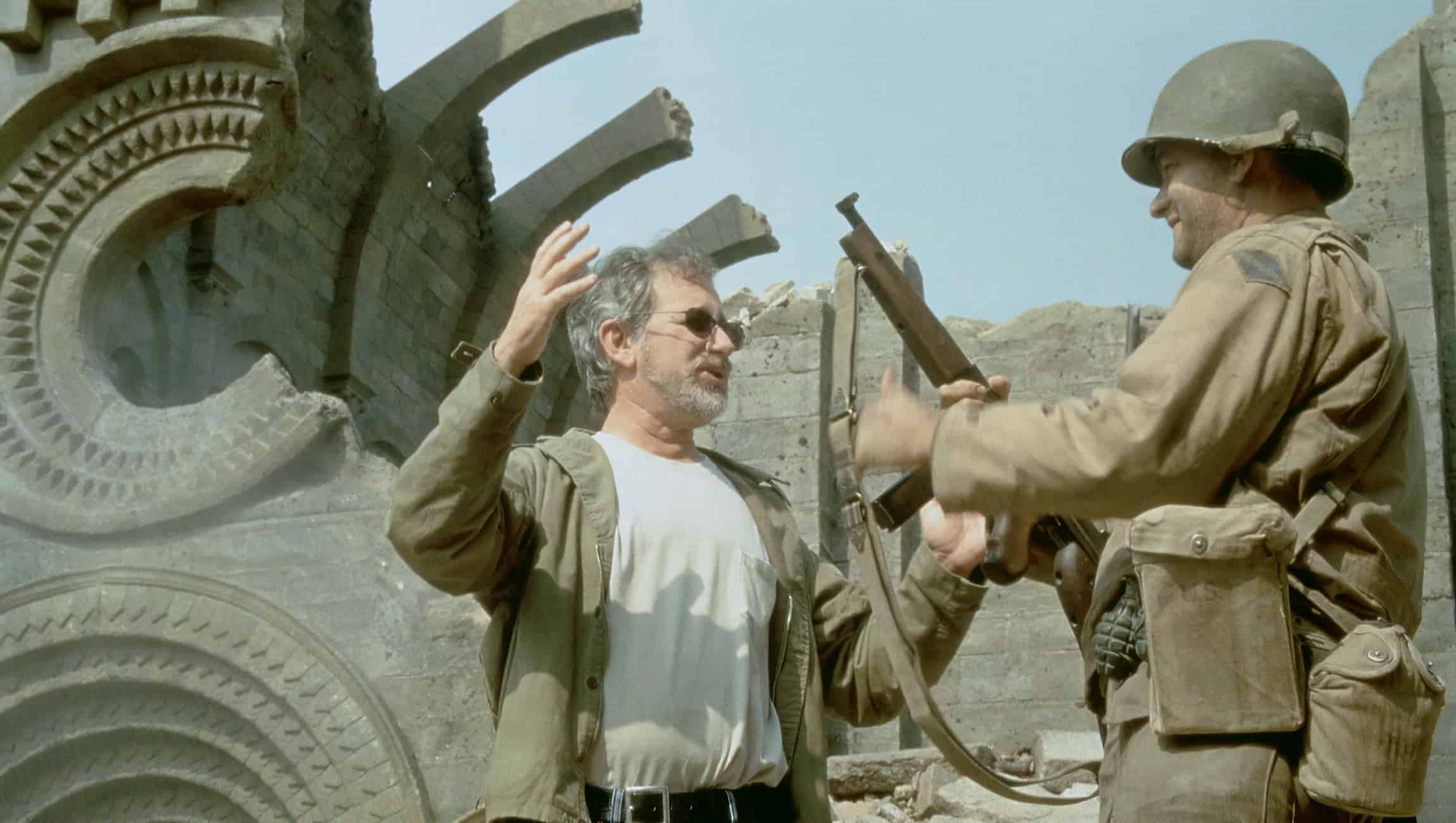
Tom Hanks and Steven Spielberg on the set
9. The cast were put through their paces
As part of training for the movie, Spielberg had the cast take part in a 10-day boot camp regime to learn what it would be like to be part of a military unit. Tom Hanks had done something similar when he’d worked on Forrest Gump (1994) and trained the Vietnam War sequence so knew how hard it would be, but the other cast members had no idea. After a few days, there was a vote amongst the actors to leave the boot camp, but Hanks overruled them.
Spielberg made every cast member attend the camp except Matt Damon. He did that because he wanted to create some resentment between the others and Damon that he was being let off easy, which is a beat from the film.
The former military officer who ran the training camp was called Dale Dye. He has a cameo in the film too – he plays one of General Marshall’s aides in the scene with the Bixby letter mentioned above.

Dale Dye trained the cast
10. Hanks was honoured for the film
In 2006, Tom Hanks was inducted into the US Army’s Ranger Hall of Fame as an honorary member, largely because of Saving Private Ryan.
11. Matt Damon was almost overlooked for the role
Matt Damon plays the titular character who requires saving – Private James Francis Ryan. At the time of casting for Saving Private Ryan, Matt Damon wasn’t yet famous and Ethan Hawke was considered to play Ryan. Neil Patrick Harris was in the running to play him as well.
Edward Norton was an actor whose star was on the rise at the time; he was offered the part but declined in favour to star in crime drama American History X (1998) instead.
Spielberg cast Damon because he wanted an unknown actor to play Ryan. However, between being cast as Ryan and the film being released, Damon co-wrote and starred in Good Will Hunting (1998), winning an Oscar for Best Screenplay. This launched him to the Hollywood A-list, so he was very well known by the time Saving Private Ryan was released.
Matt Damon as Ryan in the movie
12. Damon improvised one of his standout moments
Despite being cast as a relatively unknown actor, Matt Damon was given a fairly monologue in Saving Private Ryan. In the lead up to the climactic Battle at Ramelle sequence, Ryan talks to Miller about his brothers and tells a story about Alice, a girl who “hit every branch on the ugly tree”. The monologue wasn’t in the script – Damon ad-libbed it on the set. Spielberg liked it, so kept it in.
Ryan’s story about ‘back home’, improvised by Matt Damon
13. Ryan may have married Alice
The first scene in the film takes place in a cemetery. We see an older Ryan – played by Harrison Young – visiting the graves of fallen World War II soldiers with his family. In the novelisation of Saving Private Ryan, written by Max Allan Collins, this scene includes a lot more dialogue. In one of those lines of dialogue, Ryan calls his wife, “Alice,” suggesting he married the girl from his story.
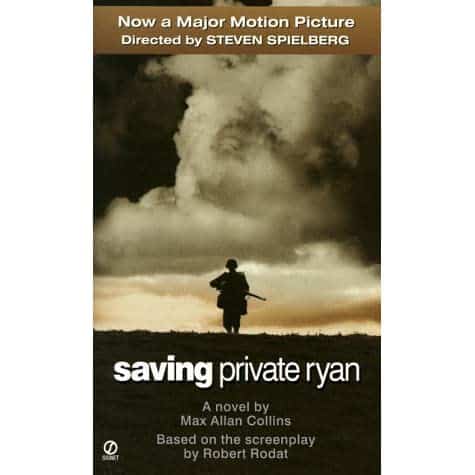
Max Alan Collins’ novelisation of Saving Private Ryan
14. The opening sequence was largely unplanned
Perhaps the most famous sequence in the film is its portrayal of the D-Day invasion. On June 6, 1944, Allied soldiers landed on Omaha Beach, Normandy, and, under heavy German gunfire manage to take the beach. It’s a huge sequence and been the topic of much discussion for its brutally graphic depiction of the horrors of warfare.
The sequence was shot over the course of four weeks on Ballinesker Beach in Ireland. Spielberg wanted to recreate the intensity, terror and urgency he heard and read about i his research. As such, he didn’t storyboard any of the sequence. Essentially, they created it on the day as they went along.
The Allies land on Omaha Beach
15. The Omaha Beach sequence was a huge production
The Normandy invasion sequence is 23 minutes long, and has gone down as part of Hollywood history. Perhaps unsurprisingly, creating the sequence was a huge undertaking:
- The budget for the entire film was $70m, and this sequence alone cost $12m.
- It took 61 days to shoot the film, and 25 of those were just on the opening sequence.
- In the whole segment we see over 1000 extras in total.
The horrors of war are depicted brutally on Omaha Beach
16. Realism was key to what Spielberg wanted to achieve
Spielberg’s concept of the film was one that presented the desperate and brutal events of 1940s warfare as realistically as possible. The whole production went to some lengths to portray that realism on the screen:
- Real amputees were used as extras for any shots of people with limbs missing.
- Local re-enactment groups who specialised in the World War II period were cast as extras in the battle scenes.
- Gunfire sound effects were recorded from live gunfire from real World War II weapons.
- Two of the landing craft used in the Omaha Beach scenes were actually used in World War II.
- Forty barrels of fake blood were used.
- And 17,000 bullet squibs were used.
17. Real life veterans praised the film’s realism
The production went to astonishing lengths to accurately depict the Omaha Beach landing and perhaps the most impressive thing is how the film was received by those who experienced it in reality.
After the film came out, The Department of Veterans Affairs in America set up a special number that former soldiers could call who were traumatized after seeing the film.
There’s a renowned military historian called Stephen Ambrose who appeared in acclaimed World War 2 documentary series World at War (1973). A special screening was arranged for Ambrose and, 20 minutes in, he had to ask for the film to be stopped. He said he was watching all of the things interviewees had been describing to him for 30 years, and he struggled to watch.
Band of Brothers (2001) – the HBO series documenting a group of marines during WWII was created by Steven Spielberg and Tom Hanks, and based on a non-fiction book of the same name written by Stephen Ambrose.

Tom Hanks, Stephen Ambrose and Steven Spielberg
18. Tom Hanks changed one of the film’s most resonant moments
One of the key moments in terms of the narrative arc of Captain Miller is his, “That’s my mission,” speech. A guarded and private man, Miller has revealed next to nothing about himself to the men under his command, leading to them making bets on what his day job is back home. After the medic, Wade, is killed in combat, Sergeant Horvath and Private Reiben almost come to blows, leading to Miller letting his guard down and revealing he is a teacher.
In the original script. Miller’s speech was a lot longer but Hanks felt that his character wouldn’t like talking about himself so said to Spielberg they should shorten it. Spielberg agreed, and they cut it down.
Miller’s monologue after Wade is killed
19. One major part of the film is entirely fictional
The first major battle sequence in the film is based heavily on real life, as we mentioned. That isn’t the case with the second. The film climaxes with the epic Battle at Ramelle sequence – a fictional town and battle created for the film.
The sequence was inspired by a real-life battle that took place in a town called La Fiere three days after Normandy. And the set for Ramelle was built at an abandoned airfield in Hatfield, England. It was the same set used for the French village we see earlier in the film – Neuville-au-Plain.
The Battle at Ramelle
20. A Star Trek legend was a big fan
James Doohan, who played the iconic character Scotty in the original Star Trek series, was a veteran of World War II. He served in the Canadian military and was part of the D-Day invasion.
Doohan was a member of the Royal Canadian Artillery and landed on Juno Beach with the 13th Field Regiment. During the invasion, Doohan was hit by six rounds from a German machine gun, which resulted in the loss of his middle finger on his right hand.
Years later, in a 1998 interview with the Archive of American Television, Doohan recounted the experience of the Normandy invasion and said: “I’m a survivor of D-Day. I was the first Canadian through the door of Normandy on D-Day.”
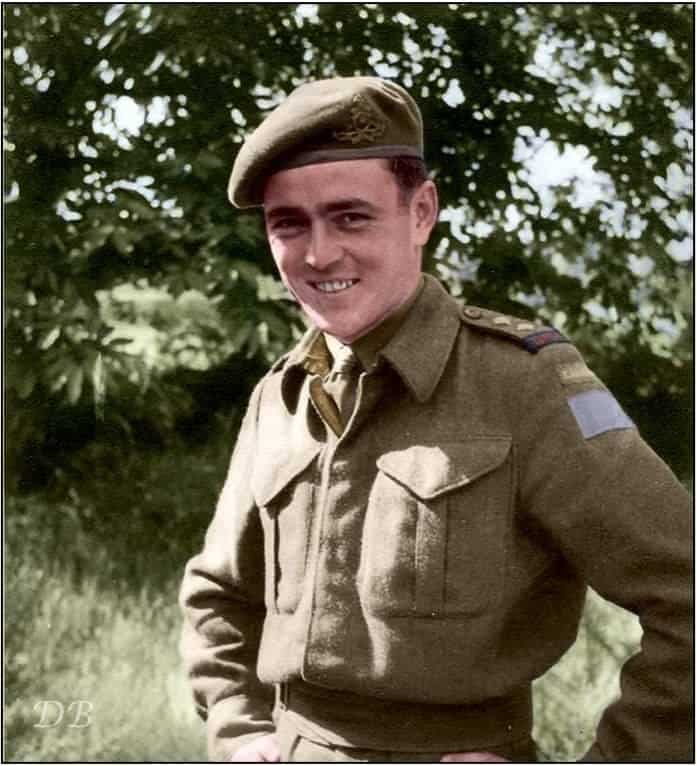
James Doohan served at the Normandy Invasion
And you’ve reached the end – 20 interesting facts about Saving Private Ryan – one of the most acclaimed World War II movies ever made. Please share on your social media channels, and subscribe to our YouTube channel for lots of great video content.
The beginning of a beautiful friendship
Stay up-to-date with all things All The Right Movies by signing up for our e-newsletter.










